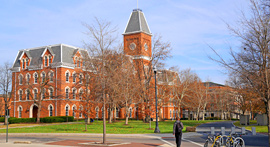Animation and Special Effects
Overview
Many believe that Stan Winston’s lifelike computer animation—his menacing “dinosaur animatronics,” featured in Jurassic Park—forever changed the way audiences could experience special effects. And there’s more groundbreaking work being done in animation and special effects every day by people with amazing ideas and the skills to pursue them. Not all programs combine the two fields, but some do, and much of the material overlaps. During your studies, you’ll learn the basics of animation, such as stop-motion and two- and three-dimensional animation, as well as how to best integrate all the elements that make an animated character come alive—the drawing itself, the dialogue, the sound effects. And the characters you create need something to do—so you’ll also learn how to plot a story.
If your interest is special effects, you’ll learn how to manipulate audiences’ audiovisual senses to create your desired impact. You’ll gain an understanding of how perception works and how this perception can be “tricked.” With your new knowledge and technical skills, you’ll be on your way to learning exactly how the jaw-dropping effects that you’ve always loved in the movies are created—and, eventually, you’ll be able to create those effects on your own or with a team.
In your pursuit of a degree in animation and special effects, you’ll also dabble in art history. And by evaluating great animators and special effects artists of the past and present, you’ll begin to perfect your own aesthetic and carry out your own creative visions.
- $55,784 Tuition
- 1370 Avg SAT
- 14,076 Enrolled
- $65,400 Tuition
- 1350 Avg SAT
- 782 Enrolled
- $39,248 Tuition
- 1180 Avg SAT
- 3,883 Enrolled
- $6,688 Tuition
- 1370 Avg SAT
- 32,221 Enrolled
- 1220 Avg SAT
- 2,377 Enrolled
View All Animation and Special Effects Schools
SAMPLE CURRICULUM
3D Character Animation
Animation Storyboarding
Digital Video & Audio
Figure & Context
Figure & Dynamics
Historical & Contemporary Issues in Electronic Art
Image & Color
Motion for Computer Animation
Observation & Color
Perceptual Systems
Raster Imaging for Computer Graphics
Special Effects for Film & Video
Vector Imaging for Computer Graphics
Visual Programming
HIGH SCHOOl PREPARATION
Explore Colleges For You
Connect with our featured colleges to find schools that both match your interests and are looking for students like you.
Top Schools for Game Design
Ready to create the next great app? Launch your gaming career at one of these top 50 programs.
Best 390 Colleges
168,000 students rate everything from their professors to their campus social scene.
Get Started on Athletic Scholarships & Recruiting!
Join athletes who were discovered, recruited & often received scholarships after connecting with NCSA's 42,000 strong network of coaches.
Explore Colleges For You
Connect with our featured colleges to find schools that both match your interests and are looking for students like you.
Top Schools for Game Design
Ready to create the next great app? Launch your gaming career at one of these top 50 programs.
Best 390 Colleges
168,000 students rate everything from their professors to their campus social scene.
Get Started on Athletic Scholarships & Recruiting!
Join athletes who were discovered, recruited & often received scholarships after connecting with NCSA's 42,000 strong network of coaches.
Explore Colleges For You
Connect with our featured colleges to find schools that both match your interests and are looking for students like you.
Top Schools for Game Design
Ready to create the next great app? Launch your gaming career at one of these top 50 programs.
Best 390 Colleges
168,000 students rate everything from their professors to their campus social scene.
Get Started on Athletic Scholarships & Recruiting!
Join athletes who were discovered, recruited & often received scholarships after connecting with NCSA's 42,000 strong network of coaches.



